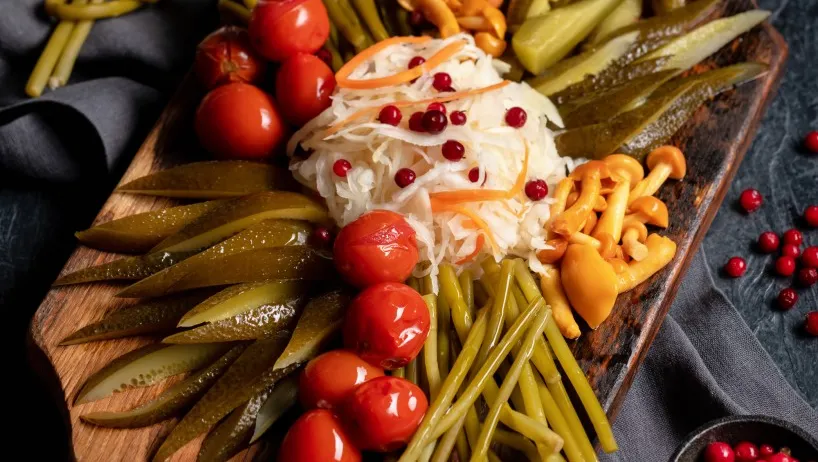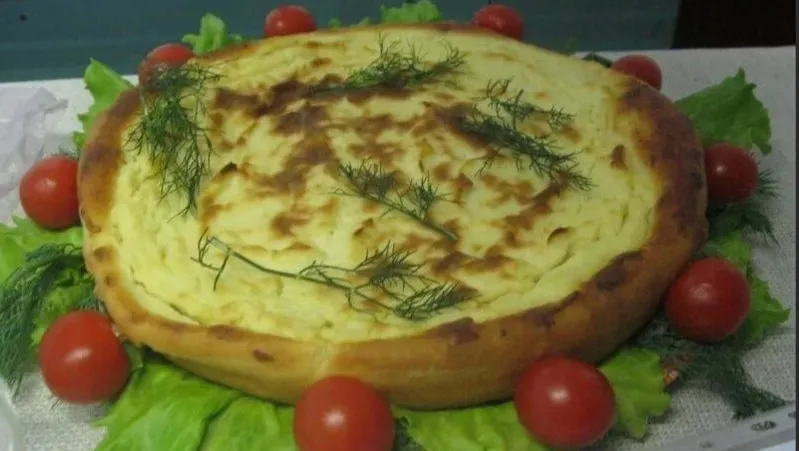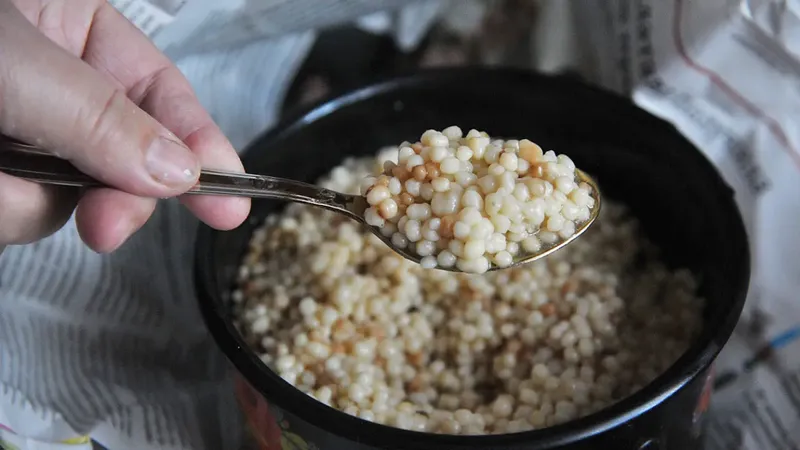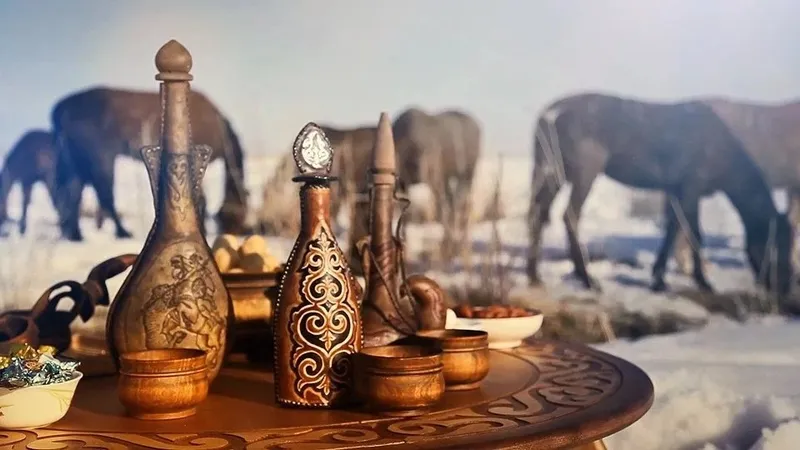Who doesn't love crunchy barrel pickles or tangy pickled tomatoes with spices? The person who invented how to pickle nature's bounty probably deserves a monument. After all, it's not only an ideal way to preserve summer vegetables, fruits, and berries but also a culinary delight and beneficial for health.
The first picklings – without salt
Pickling, soaking, and fermenting are biochemical methods of preservation based on the principle of lactic acid fermentation. The idea of preserving vegetables this way first emerged in the 12th century. Initially, it was cucumbers and cabbage.
Interesting fact: they used to pickle them without salt back then, just in water; the fermentation process would start, but the products didn't last as long. It was only later that cucumbers began to be poured with a salt solution, and cabbage was rubbed with it. There is evidence that Byzantines were the inventors of pickling, and the Slavs later adopted these recipes from them. Traditionally, fruits were pickled in oak barrels, which helped them last longer without spoiling.
If it started with cabbage and cucumbers, almost everything else was pickled afterwards – mushrooms, zucchini, eggplants, watermelons and melons, pumpkins, plums, cherries, even peas and beans.
Among the lovers of pickled cucumbers, Julius Caesar, Queen Elizabeth I of England, Napoleon, and George Washington are mentioned.
Pickling: History, Benefits, Recipes
A tasty treat
Picklings, unlike canning, do not contain vinegar and sugar, so they are not as harmful. Moreover, they are considered beneficial. In particular:
- Picklings are included in various diets since they are low in calories and fat-free.
- Many vegetables accumulate vitamins and nutrients during pickling.
- There is evidence that pickled cucumbers, tomatoes, and eggplants contain antioxidants that prevent cancer.
- The spices added to the brine (dill, garlic, mustard seeds) are also beneficial.
Pickled cabbage is considered a vitamin treasure; it improves stomach function, helps with weight loss, and protects against colds.
Tradition That Lasts a Lifetime
The gastronomic traditions of Russia date back to a time when the menus of aristocrats and common people differed not in the variety of products but in their quality and presentation. That's why pickled cucumbers and soaked fruits were eaten in both peasant huts and palaces during winter. For example, the Armory Chamber of the Kremlin houses so-called "saltcellars" from the 16th century - they contained various pickled foods served at the royal table.
While such saltcellars are now a thing of the past, the art of winter preservation in Russia is alive and well. Even in the age of supermarkets offering a full range of products, many Russian families still pickle cucumbers and ferment cabbage. However, it's done not in barrels as before but in convenient jars. But the essence (and the taste!) remains unchanged.
A Symbol of Russian Cuisine
Pickling cucumbers is a straightforward process: washed vegetables are layered with garlic cloves, umbrellas of ripe dill, currant leaves, cherry leaves, oak leaves, and horseradish. Then they are poured with hot brine, a weight is placed on top to prevent the cucumbers from floating, and they are left in a cool, dark place to ferment. However, to ensure that the cucumbers turn out aromatic and retain their firmness and crunchiness, it's important to maintain the right level of coolness. They will spoil in warmth and lose their taste in the cold. That's why barrels of pickled cucumbers were stored in haylofts, cellars, special pits in the garden, and even under the ice on the river! Historian of Russian cuisine Pavel Syutkin notes that as early as the beginning of the 20th century, near the Moskva River bridge next to the Kremlin, there were special places for this - each merchant had his own, with his own bridge. Barrels tied to the bridge were pulled out when needed in the shops. And pickled cucumbers were often needed. And it's not just because the richly spiced and salty taste of this delicacy goes wonderfully with a shot of vodka. Pickled cucumbers and brine are an essential ingredient in many traditional dishes. Based on cucumber brine, in Russia in the 16th-17th centuries, they made soup-kalya (later this recipe transformed into the modern rassolnik) and marinades. For example, one of the 16th-century books mentions beluga, sturgeon, and sigi "in brine under boiling water." And in the 20th century, pickled cucumbers even made their way into dishes where they were originally absent, such as the popular Olivier salad and vinaigrette, replacing more expensive, unavailable components for Soviet housewives and confirming the fact that any food is tastier when accompanied by a crispy, brine-soaked cucumber.
Russian Superfood
Sauerkraut is the alpha and omega of Russian cuisine, a priceless source of vitamins during the long winter. It's no wonder that cabbage was preserved in huge quantities. The Dutch traveler of the 17th century, Cornelis de Bruijn, noted that in Russia "ordinary white cabbage grows, from which Russians prepare large supplies, and which common people eat twice a day." The preservation of cabbage for the winter began at the end of September during the Feast of the Exaltation of the Cross, with the whole family participating, or even several peasant households at once. Cabbage was divided into "white" (crispy light leaves in the center of the head) and "gray" (greenish softer outer leaves). Both varieties were pickled. Gray pickled cabbage was used for cabbage soup in winter, while white cabbage was eaten as a separate dish or served as a side to meat and fish. To give flavor to the cabbage, it was layered with anise and dill seeds, cranberries, and apples. Today, cabbage is pickled in the same way, but not in barrels, but in jars, and it's used to make cabbage soup, borscht, fillings for pies, dumplings, and pastries. Also, pickled cabbage, seasoned with sunflower oil and mixed with thinly sliced onions, is a common dish on the Russian winter table.
From the Forest to the Table
Mushrooms play a huge role in Russian cuisine because they are the simplest substitute for meat in conditions where there are forests all around, but livestock farming is not very developed. That's why mushrooms have been preserved for a long time, including by pickling. Dense (or bitter) varieties of mushrooms are boiled before pickling, while mushrooms with tender flesh are simply salted using a dry method: sprinkled with salt and layered with fragrant currant leaves, cherry leaves, and horseradish, black peppercorns, and dill sprigs. Aromatic pickled mushrooms are a wonderful snack and a great way to diversify the Lenten table. They are used to make soups and fillings for pies. Pickled mushrooms fit well into recipes for various salads. For example, in the story "On the Mowing" the writer Alexander Kuprin gives a recipe for an exquisite mushroom salad: "You know, put some salty mushrooms, thinly slice a Crimean apple and one tomato, and chop a head of onion, boiled potatoes, beets, and cucumbers. Then mix all this, you know, add salt, pepper, and season with vinegar and Provencal oil, and sprinkle a little with fine sugar on top. And alongside serve melted Ukrainian lard in a sauceboat, you know, with cracklings floating and crackling in it… An amazing thing!"
Taste of Summer in Winter
For a long time, soaking was the only way to preserve fruits and berries for the winter in Russia. Lingonberries, cranberries, cloudberry, and apples (mostly Antonovka variety) were most often preserved. Writer Ivan Shmelev vividly describes the preparation of soaked apples: "Oat straw, steamed, fragrant, is laid on the bottom of the tub, golden Antonovka apples are placed on it - so that the barrels do not touch each other - and again, in rows, straw, and again apples, and everything is poured with warm water with malt. The heavy tubs are lifted, carried out carefully. The straw is removed, swept away. For many days now, the spirit of apples will walk around the house." Water with malt is water sweetened with licorice root, it not only gives the product sweetness but also prevents the growth of mold. Soaked fruits and berries were a favorite winter treat for people of all incomes. Today, few people practice this method of preserving fruits for the winter, although the result is no worse if you take a glass jar instead of a tub, and instead of malt, use sugar or honey. Ready apples should be handled carefully, like Christmas tree decorations, and just this process creates a magical holiday atmosphere. And how to eat them - as a separate treat or as a garnish for Christmas baked goose or duck - everyone decides for themselves.
If we can talk about some kind of DNA of Russian cuisine, then pickling and soaking are deeply ingrained in it for centuries. No wonder, having any products at their disposal at any time of the year, we still cannot imagine our table without crispy pickled cucumbers and fragrant sauerkraut in winter.



